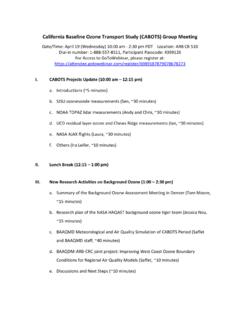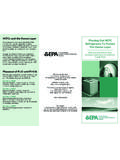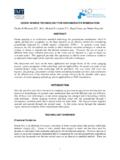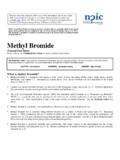Transcription of Oxygen-Ozone Treatment of the Knee, Shoulder …
1 Rivista Italiana di Ossigeno-Ozonoterapia 5: 135-144, 2006. Oxygen-Ozone Treatment of the knee , Shoulder and Hip A Personal Experience P. BENVENUTI. Orthopaedic and Neurological Recovery and Rehabilitation Unit, S. Anna Hospital; Brescia Key words: Oxygen-Ozone therapy, medical ozone , hip, knee , Shoulder SUMMARY - This paper describes the author's experience of treating acute and chronic disease of the large joints ( knee , Shoulder , hip) by intra and peri-articular injections of microdoses of an oxygen - ozone gas mixture. Three illustrative case reports are given. The patients were assessed before and after Treatment . In addition to a resolution of joint pain, patients had a good functional recovery of their daily activities and the Treatment was well-tolerated Introduction good Treatment with a high success rate, little risk of complications, easy execution, repeatability and ozone is a highly soluble gas with great oxidiz- stable outcome 4.
2 Ing activity. In contact with biological fluids ozone forms lipid oxidation products and reactive oxygen species 1,3,4. These substances react with white blood Administration and Dose cells triggering the production of cytokines, pro- teins strongly conditioning inflammatory reactions, After thorough examination of the patient and and red blood cells enhancing the oxygen supply obtaining signed informed consent to oxygen - to tissues 2. ozone injection, the gas mixture is administered. ozone is used to treat many painful syndromes Ordinary sterile conditions are maintained for dis- affecting the joints, muscles and tendons even when infection of the patient's skin as well as the syringe, peripheral neurological impairment is present 6. needles and hands. The increasing use of oxygen - Its painkilling mechanism is thought to be based ozone injections to treat inflammatory-degenera- on stimulation of the antinociceptive apparatus tive diseases of the joints has led to a specific treat- mediated by endogenous opioids and serotonin ment protocol defining the gas concentrations, thereby raising the pain threshold.
3 In addition, the doses and infiltration techniques to follow. Some marked anti-inflammatory properties of ozone authors favour a single intra-articular injection reduce oedema, joint swelling and compression on with or without instrumental guidance. Others pre- nerve root structures 7. ozone favours tissue hyper- fer the peri-articular approach with injection into oxygenation following increased vascularization certain standardized painful points for each district due to neoangiogenesis 3 improving local tissue 4,5,8.. Experience has shown that there is no single trophism and the inhibitory capacity of inflamma- effective dose for all patients: the ozone probably tory metabolites. needs to reach an activation threshold to exert its There is a consensus in literature reports that potent pharmacological effects. The latest indica- the sum of the beneficial effects of ozone reduces tions of the Italian Federation of Oxygen-Ozone local pain favouring the recovery of joint function Therapy clearly recommend smaller amounts of and motion lost during the painful phase (walk- gas 4 than in the past with slightly higher concentra- ing, going up and down staires, washing, dressing tions of ozone .)
4 The gas mixture should be inject- and feeding). ozone injections (intra-articular, ed slowly, always after aspiration. The protocol peri-articular or percutaneous) are considered a includes an initial cycle of at least five injections 135. Oxygen-Ozone Treatment of the knee , Shoulder and Hip. A Personal Experience P. Benvenuti at weekly intervals. The infiltration is usually pain- invited to perform some flexion-extension move- less. The route of administration and ozone dose ments of the knee to better distribute the drug are reported in clinical cases for each of the main throughout the joint including the recesses. joints treated 5,8. Case Report knee A 62-year-old businessman with bilateral knee The knee is the intermediate joint of the lower pain (measured as VAS 8) prevalent on the left limb. It is mainly a joint with only one degree of and with swelling of both knees (extensive on the freedom flexion-extension even though it also left) with increased tactile knee temperature and has a second accessory degree of freedom: rota- no skin reddening.
5 Physical examination disclosed tion around the longitudinal axis of the leg which painful knee joint movements throughout the occurs only when the knee is flexed. The knee range of movements with flexion possible up to essentially works in compression, under the effect 90 on the left and 110 on the right, and complete of gravity. Even though the knee joint has a good extension. Painful swelling with increased tem- mobility under the considerable body load it must perature and skin rubor was evident in the right sustain, it is composed of two refined joints (one metatarsal phalange probably due to gout arthritis could say three). The first is the inferior distal face (the patient was receiving allopurinol Treatment ). of the femur with two distinct joint regions and The patient was limited in climbing stairs (up and articular parts and the superior proximal face of down) and required a support, in dressing (putting the tibia which meets the femur with two articu- on his socks) and in walking which he managed lar parts.
6 This anatomical arrangement suggests successfully for 200-300 metres. In addition he two separate joints each working independently complained of pain at night resulting in insomnia and placed parallel to one another. The second not controlled by current anti-inflammatory treat- joint composing the knee is the femoral-rotular ment. On medical examination he produced a (or patellar) 10. During flexion, an unstable posi- knee CT scan and orthopaedic report (predating tion, the knee is particularly exposed to injury to the onset of joint swelling) noting largely normal the ligaments and meniscus. In extension, when findings ( meniscal degeneration, arthrosis of the the knee is in a highly stable joint position, joint patella ) and no indication. He underwent blood fractures or ligament rupture are more common tests which disclosed acute gout (uricaemia , Pcr 9.. knee pain is the main symptom leading patients ) with probable polyarticular involvement.
7 He to consult a specialist. Pain may be invalidating then started Treatment with bilateral intra-articular and progressive, exacerbated by movement (while Oxygen-Ozone injection into the knees of 10 ml gas walking or going up and down stairs). Swollen mixture at a concentration of 20 g/ml (a clear syn- knee is the second symptom: it reflects the synovial ovial fluid was aspirated from the joint cavity but membrane reacting to joint inflammation (caused we decided not to perform arthrocentesis and to by cartilage degeneration, trauma, overloading proceed with the infiltration). One week after the joint structures) producing synovial fluid to better first Treatment session there was a rapid reduction lubricate the joint. of joint swelling and pain (VAS 5) with a recovery Oxygen-Ozone therapy is used to treat patients of bilateral joint function (flexion 120 ). At the with gonarthosis (initial and late), inflammatory end of the five weekly injections knee swelling had disease due to overloading, patellar tendinitis, subsided with almost total remission of pain (VAS.)
8 Goosefoot bursitis of the knee , synovitis during 2) and a complete recovery of function (going up inflammatory arthritis, bursitis, knee pain caused and down stairs, walking, putting on socks). The by joint cartilage degeneration due to femoral-rot- patient was prescribed medical management for ular chondropathy, knee pain following surgery. the gout (metarsal phalange joint) per os: a full The patient is placed in a supine position with the dose of allopurinol and NSAIDs. The patient did knee in extension. After having located the patella not attend the first follow-up visit one month later its medial margin is pressed to subluxation in the and let us know he was busy in a sailing competi- lateral margin to increase the articular rim as much tion. At a recent visit knee joint function was nor- as possible. A 21G needle is inserted along the mal with no swelling. The painkilling effects of the superolateral margin of the patella (to the superior Oxygen-Ozone Treatment have persisted a long time third).
9 After thorough sepsis and aspiration, 10-15 after suspension of NSAIDs (previously during cc of the gas mixture is injected slowly at variable pain), the patient readily goes up and down stairs concentrations depending on the disease and in and walks normally. Further follow-up visits have any case not more than 25 g/ml. The patient is been scheduled, the first in four months' time. 136. Rivista Italiana di Ossigeno-Ozonoterapia 5: 135-144, 2006. A B. C D. Figure 1 A-D) MR study of the knee before Oxygen-Ozone therapy: the scan shows femoral-rotular arthrosis with erosion of the joint cartilage pannus and marginal osteophytic appositions. Erosion of the cartilage pannus of the patella of the trochlear groove appar- ently without signs of subchondral injury. Continuous collateral ligaments with marked infiltrate of the lateral and medial capsulo- ligamentous compartments. Extensive bilateral degeneration of the meniscus with barely recognizable meniscal fibrocartilage and residual material extruded from the joint margin.
10 The cartilage pannus appears thin and eroded on both condylar surfaces with signs of subchondral injury at the third middle anterior surface of the medial condyle. Fluid within the joint and infiltration of Hoffa's fat pad. Shoulder humeral joint is a highly mobile but not very stable ball-and-socket joint. Its stability is ensured by The Shoulder has great freedom of movement the glenohumeral fibrous capsule. Joint motility and serves to orientate the hand in space and depends on the rotator cuff muscles: supraspina- hence to perform most daily activities. The gleno- tus, infraspinatus, teres minor and subscapularis. 137. Oxygen-Ozone Treatment of the knee , Shoulder and Hip. A Personal Experience P. Benvenuti A B. C D. E F. 138. Rivista Italiana di Ossigeno-Ozonoterapia 5: 135-144, 2006. G H. I L. Figure 2 Shoulder MR scan after Oxygen-Ozone Treatment . The scan shows arthrosis of the acromioclavicular joint with osteophytic appositions on the inferior joint margins impressing the supraspinatous tendon.
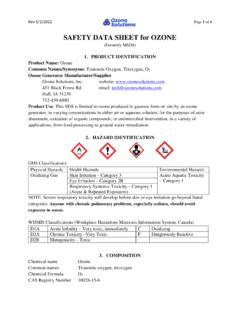

![SAFETY DATA SHEET [formerly MSDS] 1 PRODUCT …](/cache/preview/b/8/1/9/4/d/b/f/thumb-b8194dbf3233d95ad71de2848134ba9c.jpg)
